What is it like camping on the Botswana side of the Kgalagadi Transfrontier Park after two years of Covid? Alta Wessels reports back on the current state of campsites and road conditions.
Our recent trip to the Botswana side of the Kgalagadi, undertaken 3–15 March 2022, was a reminder of how much has changed. Gone are the days where, once the bookings are made, you can simply load the vehicle and be off. First you need to consider a number of things:
- What can we take? Fresh meat? No. Chicken? No. Fresh vegetables? No. Fresh fruit? Yes, but only with a permit…so, no. Fresh milk? No.
- Which route shall we take? Well hello, which border posts are open? And remember you need to go through a big enough town to buy all the goodies you couldn’t take across the border…
- What are the current Covid regulations? In the run-up to our trip this was a moving target, as the regulations seemed to change on a daily basis.
- Oh, and when planning the route for your return, remember to go via a town that is big enough to have a Diagnofirm outlet (or other lab) for the Covid PCR or rapid test required to enter into South Africa.
Once all this is covered, you can load up and go.
T4A update: Current regulations state that travellers with proof of full vaccination can enter South Africa or Botswana without a PCR test. Confirm with border officials before departure.
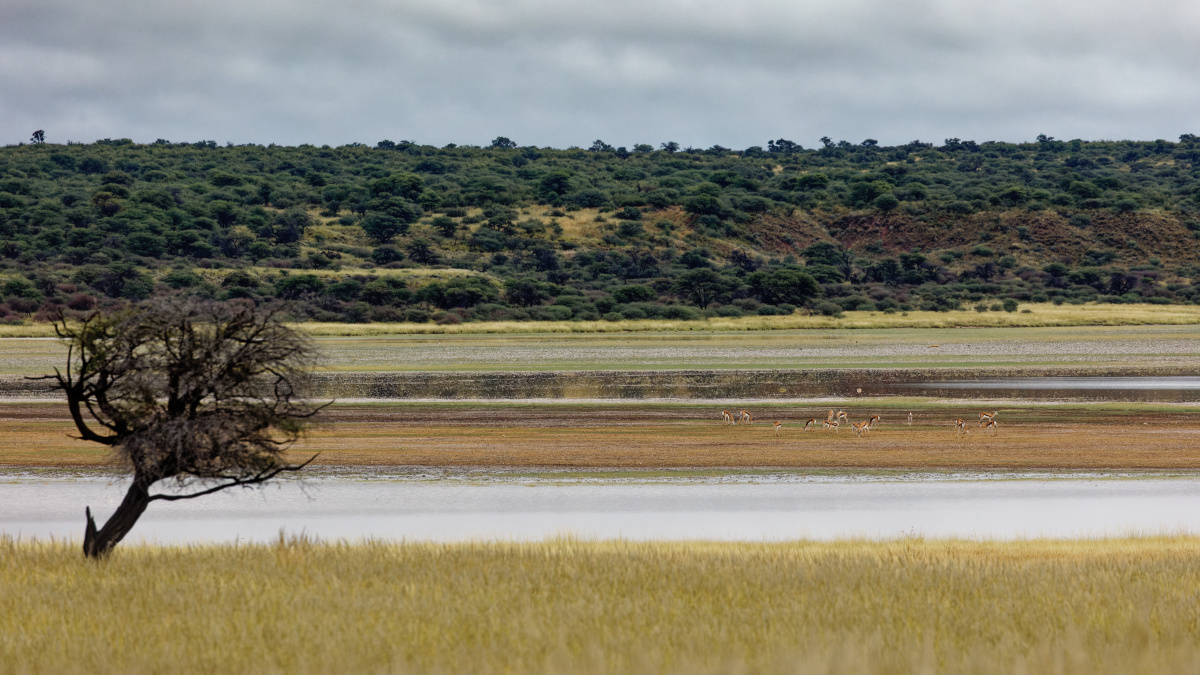
Crossing the border
As the Twee Rivieren border post is still closed, we entered Botswana via the border post of Gemsbok/Bokspits near Askham early in the morning. Officials on both sides were very friendly and formalities were completed quickly.
Because of a power failure Botswana was unable to process payment of our road transport levy. They requested we pay it at the Middelputs/Middelpits border post on our way to Tsabong. We were slightly sceptical as we knew this border post was still closed under the Covid regulations. On arrival at the Middelpits border post we found the gate locked with a chain and diverted to the police station for information. The police phoned the border post and informed us the border officials were in attendance. We were to approach the border post via the staff housing.
We did this and were quite surprised to find six officials sitting at their posts inside the closed office. Unfortunately, a significant delay ensued as – with the border post having been closed for two years – the computer login details of the officials had lapsed. These details had to be reset by IT support before they could process our payment. But eventually we could be on our way, receipt in hand.
We stopped in Tsabong to load up on fresh goods at the Sefalana Shopper and Choppies. We could get goat meat and beef at excellent prices, but the lamb was of poor quality. Chicken seemed to be completely absent and it is best to give the boerewors a wide berth. It seems like you would be better off buying meat at a butchery rather than at a supermarket. The variety of fruit and vegetables was limited and not of good quality, but such that one can get by with a little imagination.
Campsite views but no water
Our first night in Kgalagadi was at Bosobogolo No 2 (shade shelter; no other facilities). The campsite has a lovely view over the Bosobogolo Pan and what bliss to finally be able to light a fire, sit back and enjoy what nature has to dish up for you.
The next day we shifted to Lesholoago via Mpayathutlwa. The tracks in the Mabua area were in a fair condition and as they are well used, seeds and grass on the middelmannetjie did not pose a problem. This was despite the fact the grass was very long after the exceptional rainy season.
Lesholoago No. 2 is a nice roomy campsite close to the Lesholoago waterhole. Unfortunately, neither the campsite nor the waterhole had any water. The water was still functional when we were there in April last year (and according to one report as recently as December) so hopefully it will be fixed soon. Unfortunately, it seems that maintenance at the DWNP campsites in the Mabua area is way behind and has been sadly neglected for a very long time. An interesting feature of this campsite though is that it has two longdrop toilets – the one in much better condition than the other.
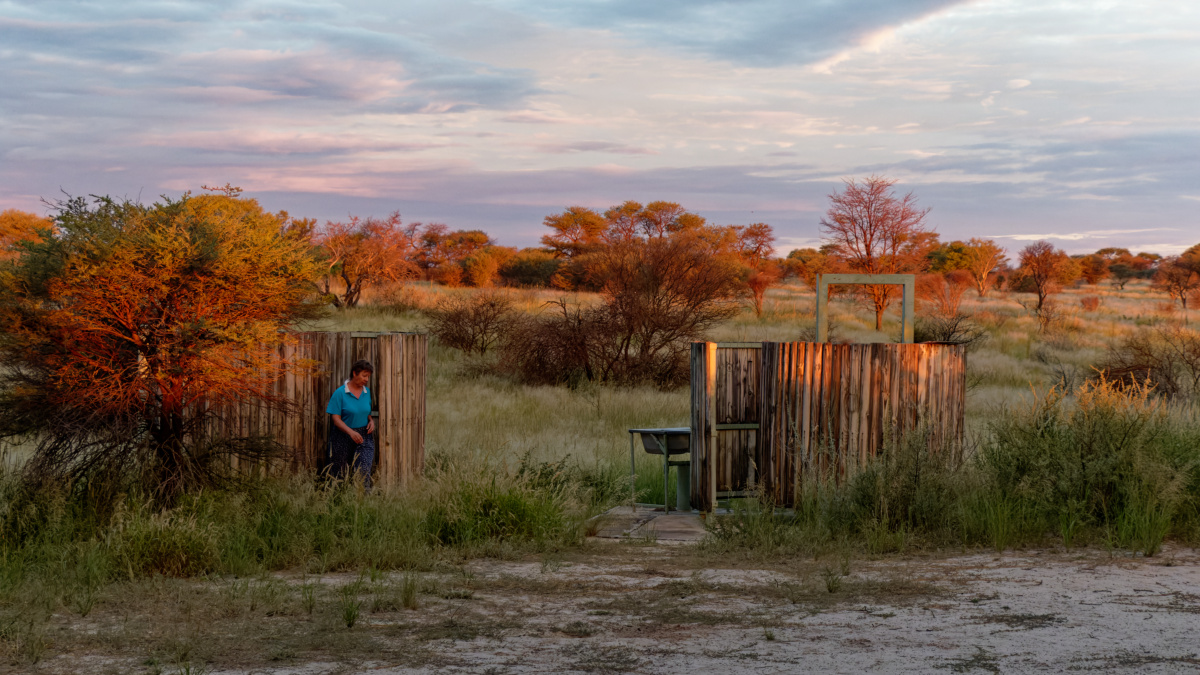
While camped at Lesholoago we had very heavy rain – so much so that when we drove past the Mabuasehube pan the next day we saw that it went from dry to lots of water overnight. It was great to see the Kalahari that wet and green, although it did make game spotting more difficult. We joked that this is the kind of year where you could “accidentally” buy a farm in the Kalahari…
Lioness at Mpayathutlwa
At Mpayathutlwa Pan a lioness that was being rehabilitated was held in a boma (fenced enclosure). According to some other tourists, she had been relocated to the park after killing cattle elsewhere. She had been in a terrible condition when she arrived, but was now looking quite well. As we understand it, the intention is to release her into the park as soon as the resident pride has become used to her. For that there is still some way to go.
While one of the males made friendly overtures to her, we witnessed another female acting very aggressively toward her. This lioness had deviated from her pride for kilometres to visit the captive female. She repeatedly charged the fence when the captive female showed herself. We were so spoilt with the most amazing lion sightings when we were in that area in April 2021. So it seemed a bit “off” to have to go see a captive lion in order to see the big cats… But had it not been for her and the resident lions coming to interact with her, we would not have had any lion sightings on this trip.
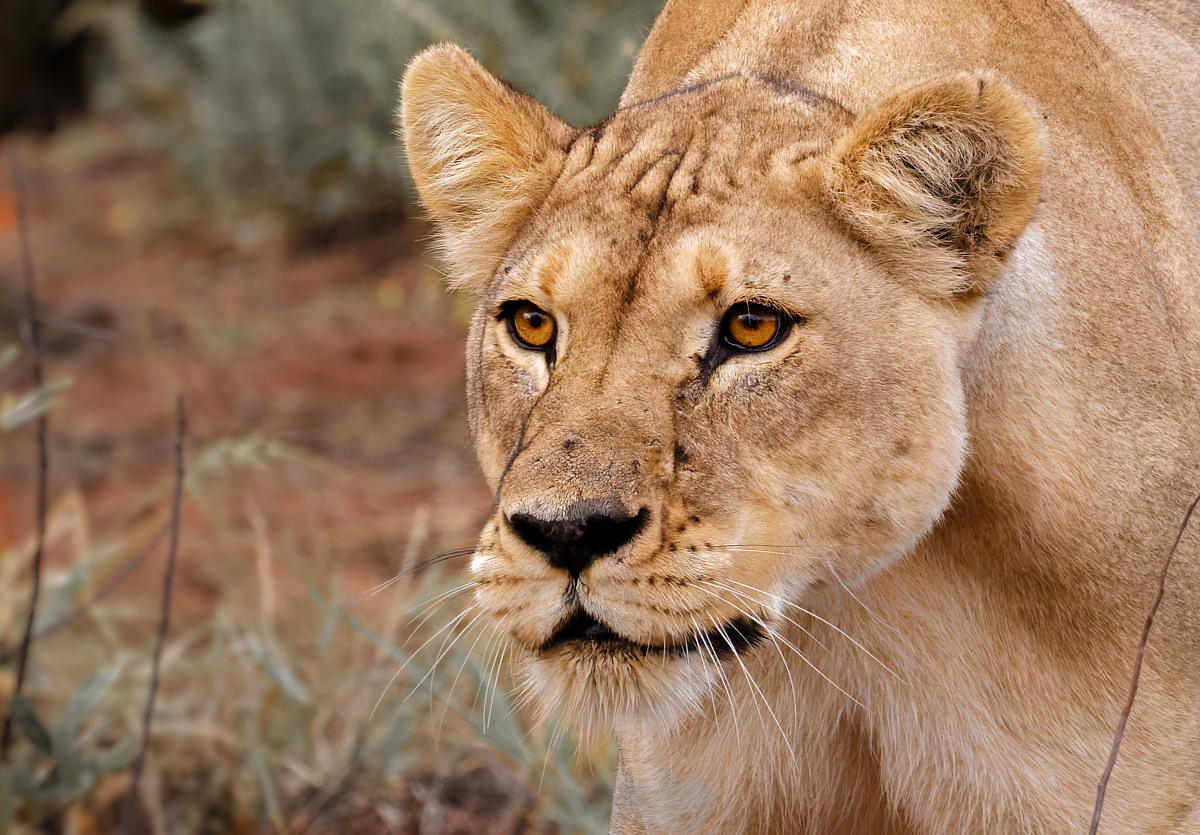
Nossob and northwards
From Lesholoago we proceeded to Bosobogolo 1 (shade shelter, shower enclosure, longdrop, no water). This camp has less of a view over the pan, but all in all was a nicer campsite than number 2.
The next day we took the two-way trail to Nossob to spend the night in luxury in one of the riverfront chalets.
From Nossob we went to camp at Swartpan: a part of the park we had not visited previously. The road north of Nossob was corrugated as usual. The Kaa access road (also known as the Kannaguass trail) was in decent condition, but not being used that frequently, seeds and grass were a problem (despite the use of a seed net). Closer to Kaa this improved and there were even signs of fairly recent track maintenance like bushes being cut back. We saw a very large herd of eland in the area – beautiful, but quite skittish and made for a fast-moving target with the camera.

This area of the park is more like the Bushveld and looks more like typical African savanna than the South African side of the park.
Slow going from Kaa to Swartpan
The access track from Kaa to Swartpan was quite overgrown, especially from Sizatswe (not to be confused with Sesatswe on the Polentswa trail) onwards. We had to stop very frequently to clear grass and seeds from the radiator and exhaust. Also, with bushes encroaching onto the road you have to accept that your vehicle will be scratched. If we remember correctly, the 75km from Kaa to Swartpan took us more than four hours.
It was a scorching day and after we had to stop to clear the radiator (myself) and around the exhaust (my husband) for the umpteenth time, I demanded a 5-star holiday for our next trip. What would I consider a 5-star holiday? My thoughts immediately went to the Okavango River Safari we’d done in 2021. You can imagine both our surprise when we realised my idea of a 5-star trip does not even include a flush toilet. What was I thinking?!
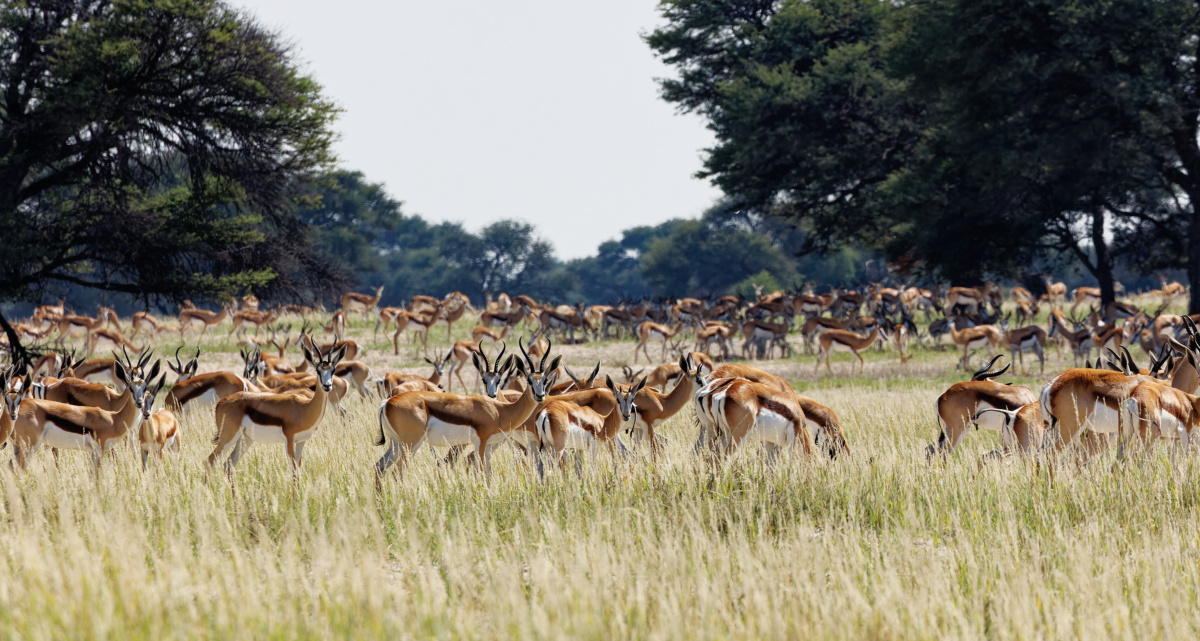
There are two waterholes at Swartpan, but neither is currently functional. When we spoke to the attendant at the Kaa gate on our way to Swartpan, he said they “are working around the clock” to fix the water. By the time we left he remarked “hopefully they would get to it in the next financial year”.
The state of the access track and the absence of water really is a shame as Swartpan is spectacular and the area exceptionally rich in game. With a bit of track maintenance and fixing the water supply Swartpan could easily rival Mpayathutlwa.
At the moment Swartpan provides utter seclusion – the attendant at the KAA gate could not remember when somebody last stayed there. But you have to be a totally self-sufficient traveller that does not mind coping with an overgrown track.
Refreshing at Kang
On the way out, we decided not to brave the access road again, but to travel along the cutlines. We first headed north along the Namibian border and then east along the cutline at the northern border of the park. This provided a fast and easy – if somewhat boring – route.
From the Kaa gate we took the track to Zutshwa and Hukuntsi on our way to Kang. The track to Zutshwa crosses through a concession area managed by the local community and a transit fee is payable. There is a self-issue permit station situated in Zutshwa. You do get something in return for your transit fee. During our visit the track was in a decent condition with clear signs of recent maintenance (encroaching bushes cut back and fallen branches picked up). Along this track we saw the largest herd of springbok we have ever seen – it must have been hundreds of them.
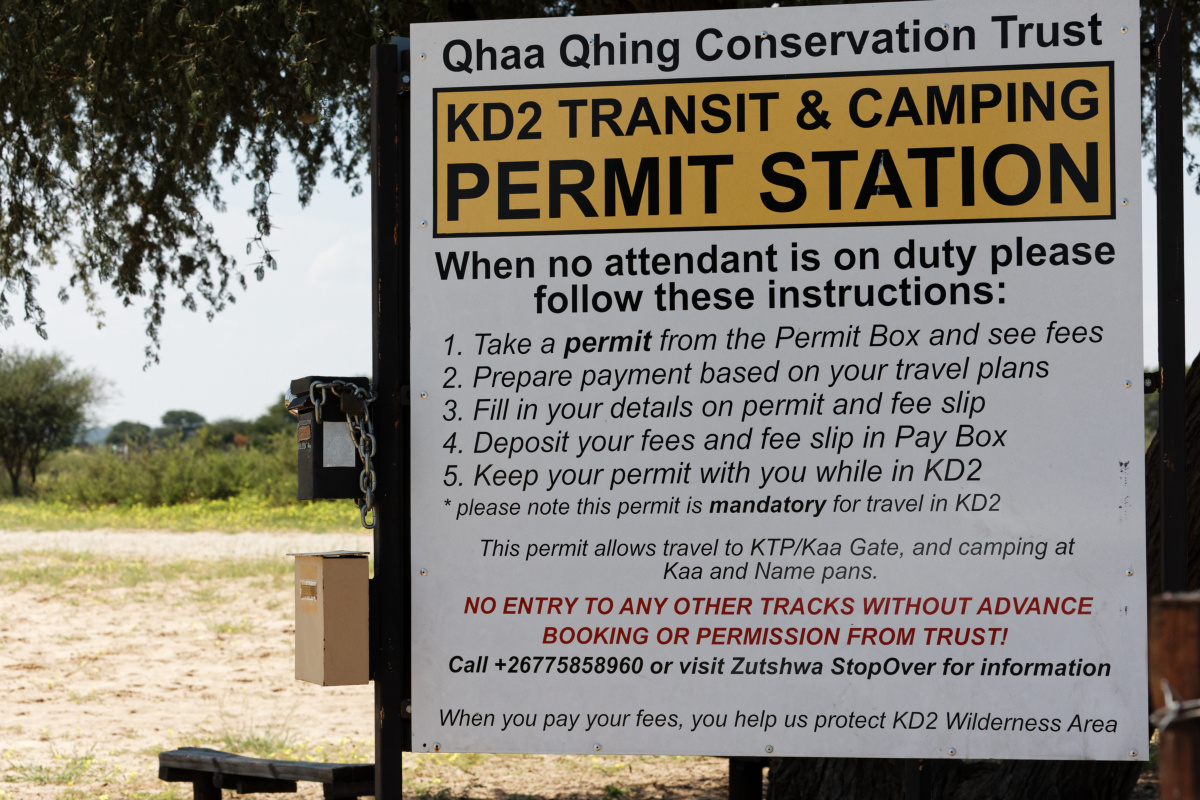
At Kang we stayed at Kalahari Rest Lodge, once again opting for the luxury of an airconditioned chalet and dinner at their restaurant. Botswana is obviously beef country – the menu at the restaurant consisted of a choice of T-bone, sirloin, rump, fillet or chicken schnitzel.
The highlight of our stay in Kang, however, was the other travellers we came across at the lodge. There was a group of four ladies travelling in two vehicles on their way to join a Bhejane tour through the Central Kalahari Game Reserve, a self-drive camping trip. What impressed us the most was the fact that the youngest in the group was 70 years old and the oldest 81! As they put it “We would rather die in a desert than an old age home.” Well done ladies, we admire your spunk!
Good sightings in Khutse
From Kang we travelled to Khutse Game Reserve. The campsites at the Khutse Pan are all reasonably close to the Khutse waterhole. Much of the vegetation in the area is of the thicket variety, so game viewing is best and easiest at the pans. Personally, I prefer the scenery in the northern part of the CKGR to that in the Khutse area. But we did have a fantastic wild dog sighting, and saw numerous giraffe, general game, raptors and signs of recent elephant activity.

The campsites at Moreswe Pan are more secluded than those at Khutse. Campsite 2 at Moreswe offers the best view of the pan. Here we also had good sightings of giraffe and other general game.
After Khutse, we sadly had to start back home and travelled to South Africa via the Ramatlabama border post after obtaining our Covid rapid tests at Diagnofirm in Molepolole.
As happens with every trip one tends to start daydreaming about the next holiday on the way back. Who knows where we will find my 5-star holiday…
Trip video
Watch a video of the trip for a closer look at road conditions and campsites.
Get the inside guide to exploring Botswana’s wild areas with our Botswana Self-drive Guide Book. It covers world-renowned protected areas like the Kgalagadi, Central Kalahari Game Reserve, Okavango Delta and the Makgadikgadi Pans. You’ll also find invaluable information on trip planning, vehicle preparation, border crossings, vet fences and more.
Main image: Giraffes at Moreswe Pan
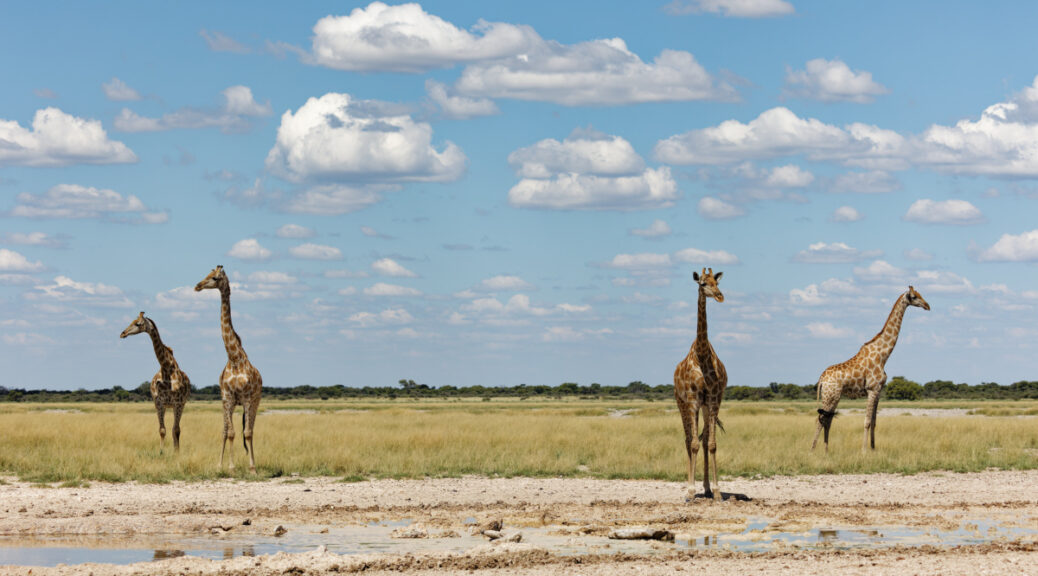

Merci pour votre récit,
nous avons eu la chance de faire le passage en 2019, j’ai toujours beaucoup de plaisir de lire des histoires vécues et surtout avoir les dernières nouvelles.
encore bravo
Thanks for sharing your updates and images of the Kgalagadi and Kalahari Alta!
Great Article, thank you
I am going to Northern Bots early next month.
I understand, and fully accept, the no fresh veg, meat, dairy etc
I am concerned about stocking up in Maun, only to come across a vet inspection and have my stuff confiscated.
So can I take fresh goods from:
Maun to Moremi
Maun to Drotsky’s Cabins, Shakawe
Drotsky’s Cabins to Camp Kwando, Kongola Caprivi
Camp Kwando (or Katima Mulilo) to Ihaha Camp, Chobe Game Res
Kasane to Elephant Camp, Nata
Elephant Camp to Khama Rhino Sanctuary, Serowe
Thanks very much
Hi Tim, you can find more information about vet fences in Botswana and Namibia in our guide books as well as our blog on the topic: https://blog.tracks4africa.co.za/veterinary-fences-in-namibia-and-botswana/ This will help you work out how much stocking up you should do in Maun, since you won’t be able to take fresh meat and animal products across the vet fences ahead of some of these destinations. While the blog makes reference to meat, at the moment the restrictions also apply to chicken (as well as eggs) and pork (including bacon).
Wonderful article. Was lucky enough to live in the Mabuase/Mpaa/Boso/Mono area and Khutse/S CKGR for some years in the 80s, so great to have an update.